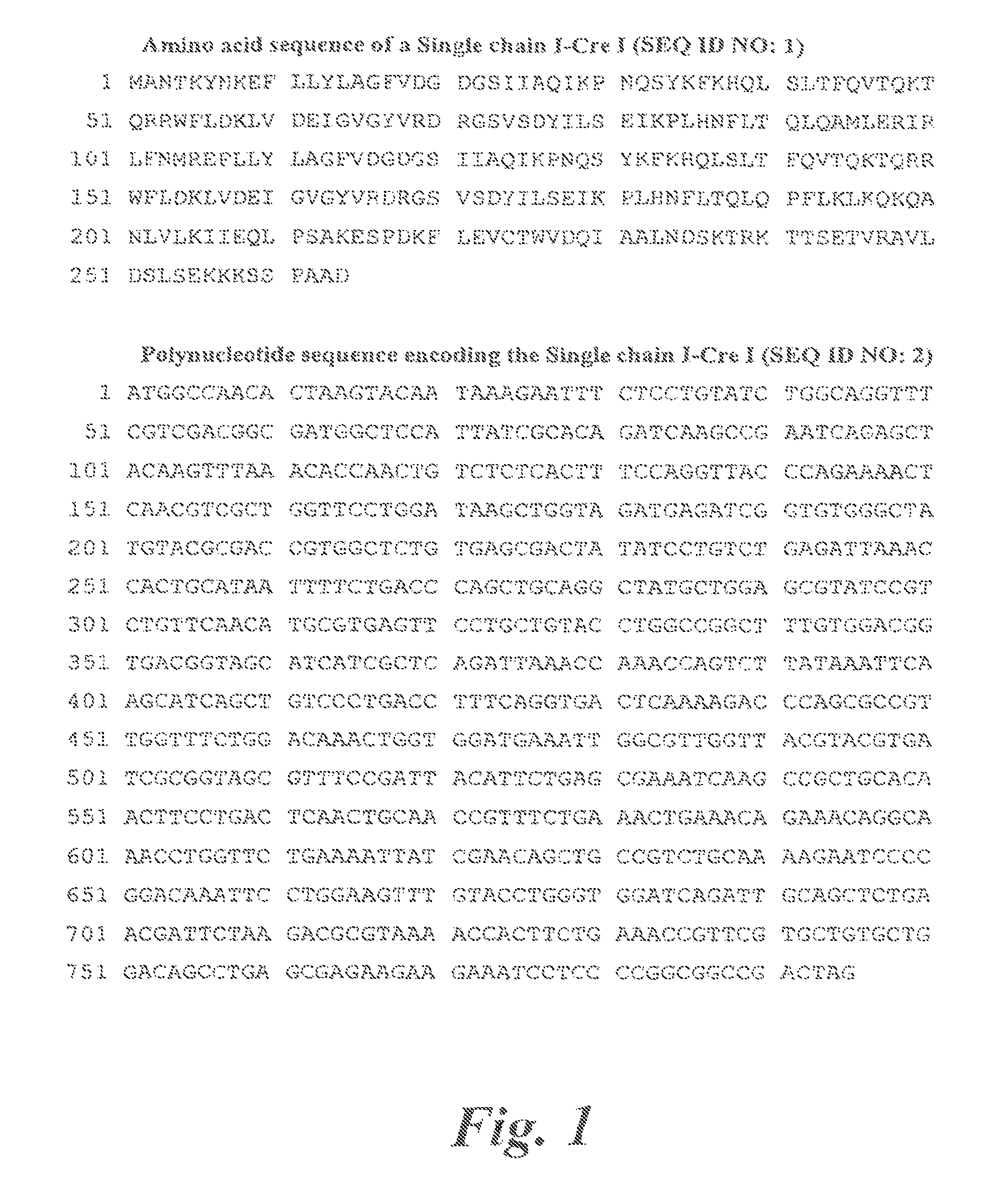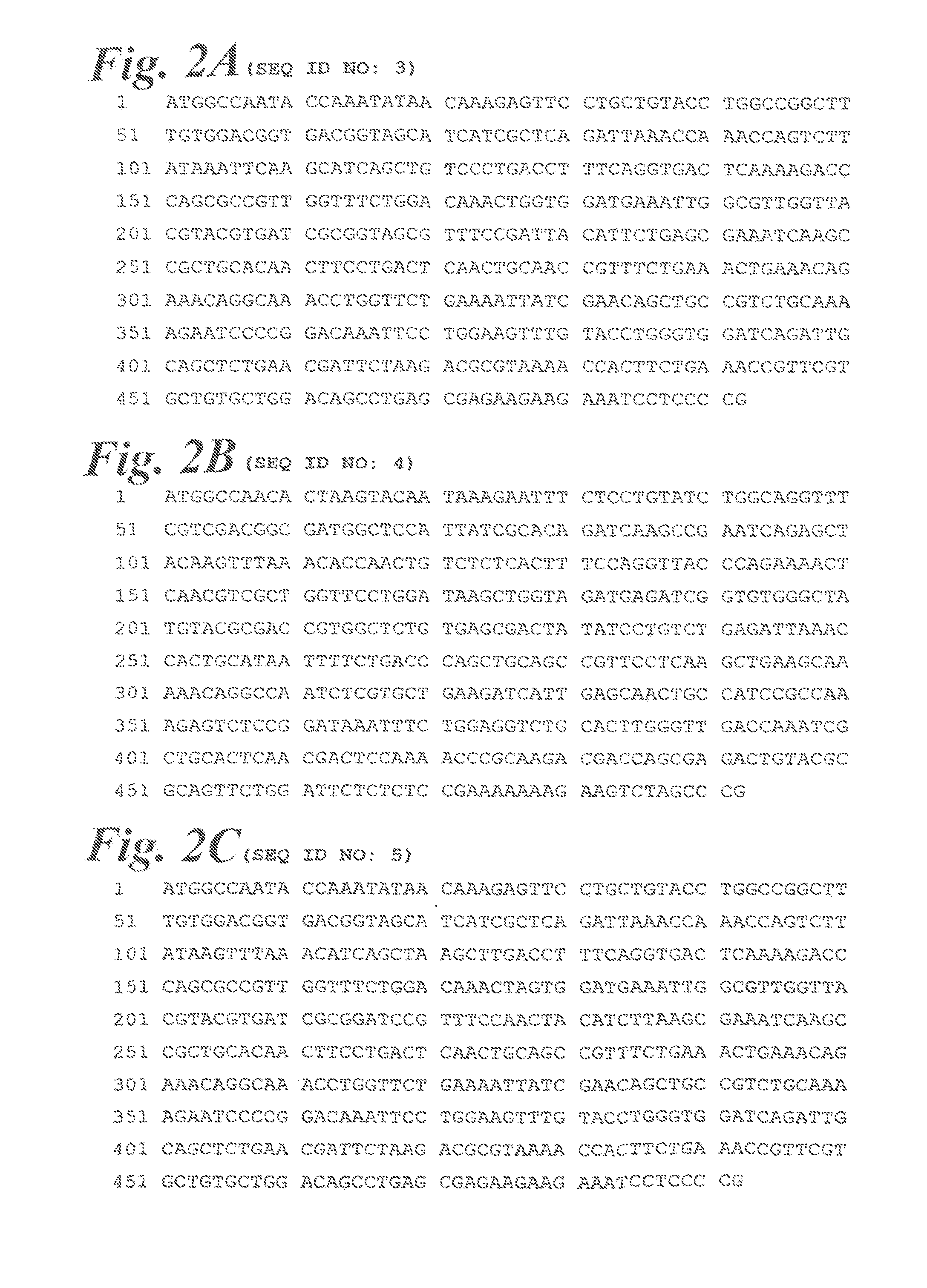Use of meganucleases for inducing homologous recombination ex vivo and in toto in vertebrate somatic tissues and application thereof
a technology of meganucleases and vertebrate somatic tissues, applied in the field of meganucleases for inducing homologous recombination ex vivo and in toto in vertebrate somatic tissues, can solve the problems of disrupting gene or its proper regulation, affecting gene expression, and affecting gene expression
- Summary
- Abstract
- Description
- Claims
- Application Information
AI Technical Summary
Benefits of technology
Problems solved by technology
Method used
Image
Examples
example 1
Single Chain Meganuclease Derived from Dimeric Homing Endonucleases
[0223]Some LAGLIDADG (SEQ ID NO: 24) homing endonucleases are active as homodimer. Each monomer mainly dimerizes through their dodecapeptide motifs. A single-chain meganuclease can be engineered by covalently binding two monomers modified such as to introduce a covalent link between the two sub-units of this enzyme. Preferably, the covalent link is introduced by creating a peptide bond between the two monomers. However, other convenient covalent links are also contemplated. The single-chain meganuclease preferably comprises two subunits from the same homing endonuclease such as single-chain I-Cre I and single-chain I-Ceu I. A single-chain meganuclease has multiple advantages. For example, a single-chain meganuclease is easier to manipulate. The single-chain meganuclease is thermodynamically favored, for example for the recognition of the target sequence, compared to a dimer formation. The single-chain meganuclease al...
example 2
Custom-Made Meganuclease Derived from I-Cre I Homing Endonuclease for HIV-2 Target
[0242]Construction of a Phage-Displayed Library of I-Cre I Variants
[0243]In order to engineer new meganuclease with altered specificities, a combinatorial library was constructed by mutagenesis of the I-Cre I homing endonuclease replacing DNA binding residues. Selection and screening applications then enabled to find those variants that were able to bind a particular, chosen DNA target. For phage display, as I-Cre I is a homodimer, a phagemid vector was required that encoded two separate I-Cre I proteins. Only one of the two I-Cre I copies, which was fused to the phage coat protein p3, was mutated. The resulting protein library, in phage display format, comprised thus I-Cre I wild-type / mutant heterodimers. Eight residues (Q26, K28, N30, Y33, Q38, Q44, R68 and R70) capable together of specific interactions with most of the bases in a single hal-site within the DNA target were selected. Our combinatorial...
example 3
Use of Meganuclease for Antiviral Therapy
[0305]Experimental Procedures
Cells
[0306]COS-7 cell lines from the American Type culture collection (ATCC) were cultured in DMEM plus 10% fetal bovine serum. PC-12 cells from ATCC were grown in RPMI1640 supplemented with 10% heat-inactivated horse serum and 5% heat-inactivated fetal bovine serum. PC-12 cells were differentiated as previously described (Su et al., 1999, Journal of Virology, 4171-4180). Briefly, cells were seeded on 6 well-plate at 5 104 cells per well. The following day, cells were incubated in PC-12 medium containing 100 ng / ml of 2.5S NGF (Invitrogen). Medium was changed every three days. After 7 days of incubation, undifferentiated cells were eliminated by adding 2 μM of fluorodeoxyuridine (FdUrd).
Construction of Recombinant HSV-1
[0307]HSV-1 was purchased from ATCC. Viruses were propagated on COS-7 cells at low MOI (0.01 PFU / cell). Recombinant virus (rHSV-1) were generated as previously described (Lachmann, R. H., Efstathiou,...
PUM
| Property | Measurement | Unit |
|---|---|---|
| molecular mass | aaaaa | aaaaa |
| MW | aaaaa | aaaaa |
| pH | aaaaa | aaaaa |
Abstract
Description
Claims
Application Information
 Login to View More
Login to View More - R&D
- Intellectual Property
- Life Sciences
- Materials
- Tech Scout
- Unparalleled Data Quality
- Higher Quality Content
- 60% Fewer Hallucinations
Browse by: Latest US Patents, China's latest patents, Technical Efficacy Thesaurus, Application Domain, Technology Topic, Popular Technical Reports.
© 2025 PatSnap. All rights reserved.Legal|Privacy policy|Modern Slavery Act Transparency Statement|Sitemap|About US| Contact US: help@patsnap.com



